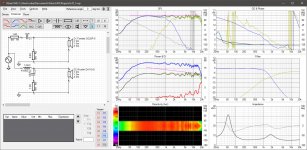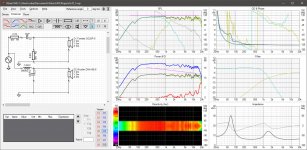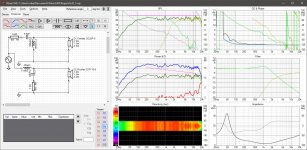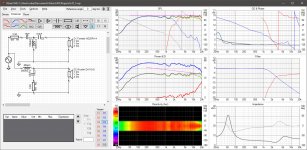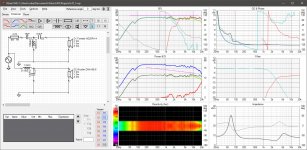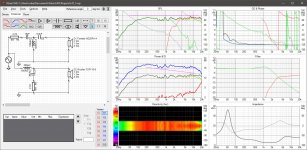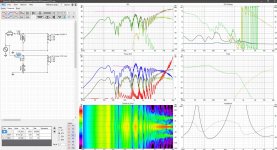Looking for feedback on a series of driver configurations and crossover designs intended for a small home theater, in a small-ish room, thinking 3 of these, left, right, and center matched.
A previous post I made got lots of feedback on what they would have done differently, and I had a bit of trouble discerning why.
Essentially I don't know what good looks like I guess, so hoping by posting several designs vs feedback I can learn what it is yall are focusing on as good or bad.
Just getting into this so please forgive my noob-ness
A previous post I made got lots of feedback on what they would have done differently, and I had a bit of trouble discerning why.
Essentially I don't know what good looks like I guess, so hoping by posting several designs vs feedback I can learn what it is yall are focusing on as good or bad.
Just getting into this so please forgive my noob-ness
Attachments
It doesn't look like you've accounted for Baffle Step losses in any of these - are you planning on wall mounting them?
If not, adding baffle step compensation will almost certainly be required.
You can use the Diffraction module from the tools menu in VituixCAD to modify the FRD's of the drivers to account for the likely effects of bafflestep before you load them into the main XO simulator.
Your first couple (DC28-DA115 & DC28-DMA105) seem to be using only a 1st order HPF at quite a low frequency - that will likely strain the tweeter a lot and result in higher distortion than you might like. Either raise the XO frequency or increase the order of the HPF to address that.
DC28-TCP115 (and to a lesser degree ND25-TCP115) allows the impedance to drop to around 2 Ohms over much of the range - that will strain a lot of amps. Try to keep above 4 Ohms minimum.
HTH,
David.
If not, adding baffle step compensation will almost certainly be required.
You can use the Diffraction module from the tools menu in VituixCAD to modify the FRD's of the drivers to account for the likely effects of bafflestep before you load them into the main XO simulator.
Your first couple (DC28-DA115 & DC28-DMA105) seem to be using only a 1st order HPF at quite a low frequency - that will likely strain the tweeter a lot and result in higher distortion than you might like. Either raise the XO frequency or increase the order of the HPF to address that.
DC28-TCP115 (and to a lesser degree ND25-TCP115) allows the impedance to drop to around 2 Ohms over much of the range - that will strain a lot of amps. Try to keep above 4 Ohms minimum.
HTH,
David.
More to that, the two drivers will play the same signal together and the result will be that you'll hear same sound from the speakers swinging from one to another, result of shifting & combing... 😱Your first couple (DC28-DA115 & DC28-DMA105) seem to be using only a 1st order HPF at quite a low frequency - that will likely strain the tweeter a lot and result in higher distortion than you might like. Either raise the XO frequency or increase the order of the HPF to address that.
Interesting, I used to cross domes first order at 1.4kHz. Your group delay looks good in the critical frequency range.
May I ask a question for my own purposes, how did you get VC to show this directivity, the 45 degree polar plot, the power/axial discrepancy at the top end. Since you are crossing at 0 degrees, I assume you have taken one measurement per driver? So did you tell VC the dimensions of your dome, or did it just do this automatically?
On this topic, this is the reason that optimising and listening off axis can be different, and often better.
May I ask a question for my own purposes, how did you get VC to show this directivity, the 45 degree polar plot, the power/axial discrepancy at the top end. Since you are crossing at 0 degrees, I assume you have taken one measurement per driver? So did you tell VC the dimensions of your dome, or did it just do this automatically?
On this topic, this is the reason that optimising and listening off axis can be different, and often better.
@ AllenB: I suspect prolow is using the standard FRD's supplied by Dayton (they're all Dayton model numbers after all); they supply 0, 15, 30 & 45 degree FRD's so I assume prolow has just loaded all of them for VCad to display the resulting directivity.
modeled enclosure and diffraction and... that went to ****.
sure I could be doing parts of this wrong, but floors and walls had the largest impact, baffle size and driver position on the baffle much less so.
Hard to tell what crossover design can really correct with all those ripples.
sure I could be doing parts of this wrong, but floors and walls had the largest impact, baffle size and driver position on the baffle much less so.
Hard to tell what crossover design can really correct with all those ripples.
Attachments
Your crossover can't fix that. Not because it would be difficult, but because the sound is different everywhere in the room. The speaker/room have mixed it up, as they tend to do, and no crossover action can undo this. This is a matter of speaker/enclosure/room acoustic design.
When doing the crossover, you want to work the speaker without the room.
When doing the crossover, you want to work the speaker without the room.
- Home
- Loudspeakers
- Multi-Way
- Driver / Crossover designs - feedback wanted
